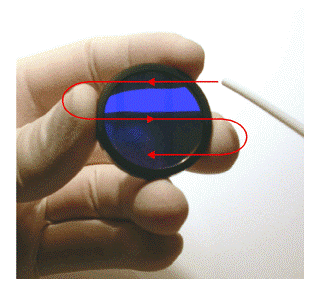Introduction
The Light Microscope, an invaluable tool for scientists and researchers, offers a glimpse into the minuscule world of cells, molecules, and materials. However, lurking in the shadows of microscopic revelations is a formidable adversary – scattered light. In this article, we will explore the primary causes of scattered light in microscopy and delve into why it is detrimental to the pursuit of clear and precise images. Moreover, we will discuss effective strategies to mitigate its effects.
The Culprits: Leading Causes of Scattered Light in Microscopy
- Surface Roughness: The presence of microscopic imperfections on optical components, including lens surfaces, filters and mirrors, is a major culprit behind scattered light. Even the tiniest irregularities can divert light in various directions, severely impairing image quality.
- Reflections: At the interfaces between different optical elements within the microscope, a portion of incoming light undergoes reflection rather than transmission. Multiple reflections can compound the problem of scattered light.
- Refraction: As light passes through materials with different refractive indices, it may experience refraction, potentially causing scattering if the optical interfaces are not perfectly smooth or if imperfections exist within the optical components.
- Aberrations: Optical aberrations, such as spherical aberration and coma, can distort light paths, causing improper convergence or divergence of light. This not only degrades image quality but also contributes to the scattering of light.
- Unwanted Reflections and Diffraction: Even in the presence of anti-reflective coatings on optical components, some light can still be reflected. Additionally, diffraction effects at edges and apertures within the optical system can amplify scattered light.
- Contaminants and Dust: Minute foreign particles, such as dust, fingerprints, or contaminants on optical surfaces, are notorious for scattering light. Even the smallest particles can disperse light in multiple directions, leading to a loss of image clarity.
- Non-Ideal Optical Design: Suboptimal arrangements of optical elements in poorly designed microscope systems can exacerbate scattered light issues. Proper optical design is essential to minimize the impact of these imperfections.
The Detriment: Why Scattered Light is Bad for Microscopy
Scattered light presents a host of challenges and drawbacks in microscopy:
- Reduced Contrast: Scattered light reduces the contrast of images, making it difficult to distinguish fine details in microscopic samples. This results in a loss of clarity and obscures vital features.
- Impaired Resolution: Microscopy relies on high resolution to unveil the intricate world of small-scale structures. Scattered light interferes with the formation of crisp, well-defined images, degrading the system’s ability to resolve minute details accurately.
- Information Loss: In the realm of microscopic research, scattered light can obscure or conceal critical features and data within samples. This is particularly problematic when examining low-contrast or faint structures, such as in biological studies or material analysis, where missed details can lead to incomplete findings.
- Glare and Optical Artifacts: Scattered light gives rise to unwanted glare, halos, and optical artifacts around high-intensity regions in images. These distractions hinder the accurate interpretation of microscopic subjects and may overshadow essential details.
- Ghost Images: Ghost images, unwanted artifacts introduced by scattered light, can overlap with the intended view, causing confusion and misinterpretation. In research scenarios where precision and accuracy are paramount, such as cellular imaging and material analysis, the presence of ghost images can lead to erroneous conclusions and unreliable analyses.
- Stray Light Contamination: In microscopy, where precise measurement of light intensities and optical properties is often necessary, scattered light can contaminate these measurements, leading to inaccuracies in results. Researchers rely on the fidelity of their microscopic images and data, making scattered light a hindrance to their work.
Mitigation Strategies: Taming the Scattered Light
To combat the adverse effects of scattered light in microscopy, a set of effective mitigation strategies can be employed:
- High-Quality Optical Components: Invest in top-notch optical components with precision manufacturing techniques to minimize surface imperfections and irregularities. Semrock has been producing filters for fluorescence microscopes for over 20 years and set a gold standard for their filters.
- Anti-reflective Coatings: Apply anti-reflective coatings to optical surfaces to reduce reflection and enhance light transmission, significantly reducing scattered light.
- Regular Maintenance: Keep optical components and surfaces clean and free from contaminants. Consistent cleaning and maintenance are essential to prevent scattered light due to dust, fingerprints, and other particles. To find out how to clean your filters, check out our video:
- Prevent Stray Light Re-entering the Light Path: when possible, use housing to enclose optics and filters, this reduces light bypassing filters just outside the edges or entering or exiting via the edges. If this is not possible, Semrock offers Edge Blackening which is the application of a matte black, light-absorbing paint to the edges of an optical filter. This technique absorbs ~98% of light with the remainder reflected diffusely back into the filter interior.
- Aperture Control: Configure and manage apertures in the optical system properly to minimize diffraction effects, which can help control scattered light in microscopy.
- Illumination Control: Utilize Köhler illumination or advanced illumination techniques to ensure uniform and controlled lighting, thereby reducing the impact of scattered light on microscopy.

Conclusion
Scattered light is indeed a formidable adversary in microscopy, casting shadows on the quest for clear and precise microscopic images. By understanding its primary causes and implementing effective mitigation strategies, researchers and microscopists can elevate the quality and clarity of their microscopic observations. These strategies allow us to unveil the microscopic world with the precision and detail it warrants, advancing scientific discoveries and enhancing our understanding of the tiny wonders that abound in the microcosm. Scattered light may pose challenges, but with the right tools and knowledge, it can be subdued in the relentless pursuit of scientific inquiry.






























